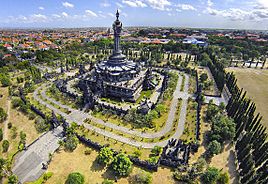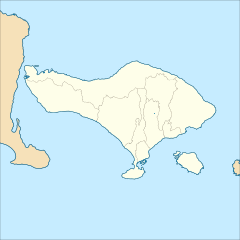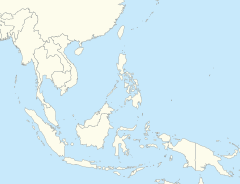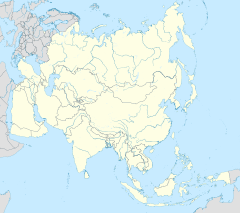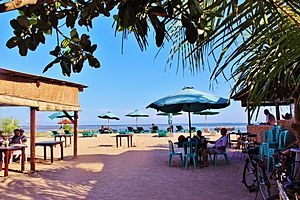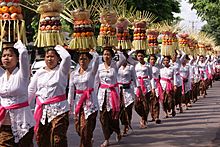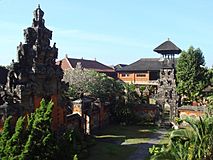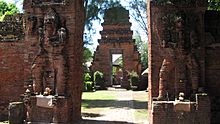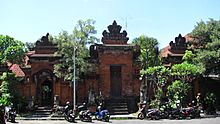Denpasar facts for kids
Quick facts for kids
Denpasar
Dénpasar
|
|||
|---|---|---|---|
|
City and provincial capital
|
|||
| City of Denpasar Kota Denpasar |
|||
| Regional transcription(s) | |||
|
Bajra Sandhi Monument
Bali Museum
Sanur Beach
Badung Market
Pura Tirta Empul
|
|||
|
|||
| Motto(s):
Puradhipa Bhara Bhavana
(The Capital Supports The Country) |
|||
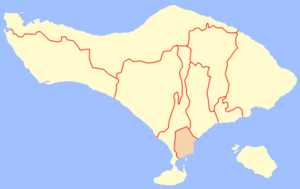
|
|||
|
OpenStreetMap
|
|||
| Country | |||
| Region | Lesser Sunda Islands | ||
| Province | |||
| Settled | 27 February 1788 Independent from Badung Kingdom | ||
| Area | |||
| • City and provincial capital | 125.98 km2 (48.64 sq mi) | ||
| • Metro | 722.19 km2 (278.84 sq mi) | ||
| Population
(mid 2022 estimate)
|
|||
| • City and provincial capital | 726,808 | ||
| • Density | 5,769.23/km2 (14,942.2/sq mi) | ||
| • Metro | 1,785,800 | ||
| • Metro density | 2,472.76/km2 (6,404.41/sq mi) | ||
| Demographics | |||
| • Ethnic groups (2010) |
Balinese (65.18%) Javanese (25.78%) Chinese (1.13%) Sasak (1.05%) Madura (0.78%) Sundanese (0.70%) Flores (0.53%) Batak (0.43%) others (4.42%) |
||
| • Religion (2020) | Hinduism 63.3% Islam 28.65% Protestantism 5.04% Catholicism 2.36% Buddhism 2.37% Confucianism 0.03% Others 0.02% |
||
| • Languages | Indonesian (official) Balinese (regional) English (international) Javanese (minority) |
||
| Time zone | UTC+8 (Indonesia Central Time) | ||
| Area code | (+62) 361 | ||
| Vehicle registration | DK | ||
| HDI (2022) | |||
Denpasar is the exciting capital city of Bali, Indonesia. It's like the main door to Bali, a famous island known for its beauty. Denpasar is also a busy center for other cities in the Lesser Sunda Islands.
Over the years, tourism in Bali has grown a lot. This has helped Denpasar become a very active city for businesses. In fact, it has the fastest growth rate in Bali Province! In mid-2022, about 726,808 people lived in Denpasar. The larger area around Denpasar, called Sarbagita, had about 1,785,800 people.
Contents
- What Does Denpasar Mean?
- A Look Back at Denpasar's History
- Denpasar's Location and Landscape
- People and Culture of Denpasar
- How Denpasar is Governed
- Denpasar's Economy
- Architecture and City Design
- Fun Things to Do in Denpasar
- Learning in Denpasar
- Getting Around Denpasar
- Sports in Denpasar
- Culture and Interesting Places to See
- Denpasar's Sister Cities
- See also
What Does Denpasar Mean?
The name Denpasar comes from two Balinese words: "den" which means north, and "pasar" which means market. So, Denpasar means "north market." This name shows that the city started as a market town. Today, that old market area is where Kumbasari Market is located.
A Look Back at Denpasar's History
Denpasar in the Past: The Colonial Era
Long ago, in the 1700s and 1800s, Denpasar was the capital of the Hindu Majapahit Kingdom of Badung. Back then, it was even called Badung. In 1906, the Dutch army arrived. The royal palace was destroyed.
There's a special statue in Taman Puputan, Denpasar's main square. It remembers an event from 1906 called the Puputan. This was when many Balinese people, including their King, chose to end their lives rather than give up to the Dutch soldiers.
Denpasar Becomes Independent
In 1958, Denpasar became the main government center for the whole Bali Province. It was also the administrative center for both Badung Regency and Denpasar City.
Denpasar grew very quickly, becoming a hub for business, education, industry, and tourism. As the city grew, it faced new challenges. To help manage its fast growth, Denpasar became an independent city on January 15, 1992. This meant it could manage its own affairs.
Later, in 2009, the capital of Badung Regency moved from Denpasar to Mangupura.
Denpasar's Location and Landscape
Denpasar is located very close to sea level, only about 4 meters (13 feet) above the ocean. The city covers an area of 125.98 square kilometers. A river called Badung River flows through Denpasar and then into the Gulf of Benoa.
Denpasar's Weather
Denpasar is near the equator, so it has a tropical savanna climate. This means it's hot and humid all year round, with temperatures usually around 28 degrees Celsius (82 degrees Fahrenheit). There are two main seasons:
- Wet season: From November to May.
- Dry season: From June to October.
| Climate data for Denpasar, Bali | |||||||||||||
|---|---|---|---|---|---|---|---|---|---|---|---|---|---|
| Month | Jan | Feb | Mar | Apr | May | Jun | Jul | Aug | Sep | Oct | Nov | Dec | Year |
| Mean daily maximum °C (°F) | 30.8 (87.4) |
31.0 (87.8) |
31.2 (88.2) |
31.7 (89.1) |
31.5 (88.7) |
30.7 (87.3) |
29.9 (85.8) |
30.2 (86.4) |
30.9 (87.6) |
31.4 (88.5) |
31.6 (88.9) |
31.3 (88.3) |
31.0 (87.8) |
| Daily mean °C (°F) | 26.9 (80.4) |
27.0 (80.6) |
27.0 (80.6) |
27.1 (80.8) |
26.8 (80.2) |
26.0 (78.8) |
25.6 (78.1) |
25.8 (78.4) |
26.3 (79.3) |
26.9 (80.4) |
27.2 (81.0) |
27.2 (81.0) |
26.7 (80.0) |
| Mean daily minimum °C (°F) | 23.1 (73.6) |
23.1 (73.6) |
22.9 (73.2) |
22.5 (72.5) |
22.2 (72.0) |
21.4 (70.5) |
21.4 (70.5) |
21.4 (70.5) |
21.8 (71.2) |
22.5 (72.5) |
22.9 (73.2) |
23.1 (73.6) |
22.4 (72.2) |
| Average precipitation mm (inches) | 323 (12.7) |
251 (9.9) |
199 (7.8) |
89 (3.5) |
86 (3.4) |
75 (3.0) |
67 (2.6) |
47 (1.9) |
46 (1.8) |
117 (4.6) |
162 (6.4) |
279 (11.0) |
1,741 (68.6) |
| Mean monthly sunshine hours | 173.1 | 174.0 | 210.7 | 224.7 | 242.9 | 228.1 | 246.8 | 261.7 | 251.3 | 252.5 | 224.4 | 176.4 | 2,666.6 |
| Average ultraviolet index | 13 | 13 | 13 | 13 | 11 | 9 | 9 | 12 | 13 | 13 | 13 | 13 | 12 |
| Source: WeatherOnline (2000–2019 sunshine data) | |||||||||||||
People and Culture of Denpasar
In mid-2022, Denpasar had about 726,808 residents. The city's population grew quickly between 2000 and 2010.
Most people in Denpasar are Hindus, making up about 63.3% of the population. Islam is the next largest religion, followed by Christianity and Buddhism.
Religion in Denpasar Balinese Hinduism (63.3%) Islam (28.65%) Protestantism (4.4%) Roman Catholic (2.05%) Buddhism (1.47%) Confucianism and others (0.13%)
How Denpasar is Governed
Denpasar's city government is divided into four main areas called districts (or kecamatan). These districts are further split into 43 villages. The city government works hard to improve services for its people.
Denpasar's Districts
List of districts and sub-districts in Denpasar City
Here are the four districts of Denpasar and how many people lived in them in 2022:
- Denpasar Selatan (South Denpasar): 217,548 people
- Denpasar Timur (East Denpasar): 128,540 people
- Denpasar Barat (West Denpasar): 207,384 people
- Denpasar Utara (North Denpasar): 173,336 people
Greater Denpasar Area
The larger area around Denpasar is known as Sarbagita. This name is a mix of the first parts of Denpasar, Badung, Gianyar, and Tabanan, which are nearby regions. This bigger area includes many popular tourist spots like Kuta and Ubud. In mid-2022, the Sarbagita area had about 1,785,800 residents.
| Administrative division | Area in km2) |
Pop'n 2010 Census |
Pop'n 2020 Census |
Pop'n mid 2022 Estimate |
Pop'n density per km2) |
|---|---|---|---|---|---|
| Denpasar Municipality | 125.98 | 788,445 | 725,314 | 726,808 | 5,769.2 |
| Badung Regency (part (a)) | 303.52 | 517,089 | 517,178 | 516,400 | 1,701.4 |
| Gianyar Regency (part (b)) | 187.69 | 332,470 | 367,080 | 373,700 | 1,991.0 |
| Tabanan Regency (part (c)) | 105.00 | 154,741 | 166,726 | 168,900 | 1,608.6 |
| Denpasar Metropolitan Area (Sarbagita) |
722.19 | 1,792,745 | 1,776,298 | 1,785,800 | 2,472.6 |
Notes: (a) Kuta Selatan, Kuta, Kuta Utara, Mengwi and Abiansemal Districts. (b) Sukawati, Blahbatuh, Ubud and Gianyar Districts. (c) Kediri and Tabanan Districts.
Denpasar's Economy
Tourism has greatly changed Denpasar's economy. Businesses like trade, hotels, and restaurants are very important to the city's income.
Denpasar is also known for its beautiful handmade crafts, like carvings and sculptures. However, these craft industries face challenges from other countries that make similar items using machines, which can produce more goods faster. Denpasar's crafts are still made using traditional skills and by hand, which limits how many can be made.
Architecture and City Design
In the past, Bali was known for its unique mud walls and thatched gates. But now, Denpasar has more modern buildings like gated communities and shop houses.
In the late 1800s, the city was built around the royal family's palace. Market squares were also very important. Even as the city grew and changed with new influences, the traditional Balinese culture remained strong.
Today, Denpasar continues to develop rapidly due to tourism. Many modern buildings have been built. However, the market squares still play a key role, and their designs often show traditional Balinese elements.
Fun Things to Do in Denpasar
Denpasar offers many exciting attractions for visitors. Its white sandy beaches are famous across Bali.
- Serangan Island is a great spot for surfing.
- Sanur Beach has calm waters, perfect for sunbathing and kitesurfing.
Just a short drive from the Ngurah Rai International Airport is Kuta. This town (which is not part of Denpasar city itself) has many hotels, restaurants, malls, and spas for tourists. In Denpasar, you can find all kinds of Balinese handicrafts in local shops, including artwork, pottery, textiles, and silver. You can also buy Batik cloth, which is a traditional fabric, and batik sarongs and shirts.
Learning in Denpasar
Denpasar is home to several important universities and schools. Some of these include:
- Udayana University
- Warmadewa University
- University of National Education
- Dwijendra University
- Mahasaraswati University of Denpasar
- Indonesian Institute of the Arts, Denpasar
- Indonesia Open University (Universitas Terbuka), which offers distance learning.
Getting Around Denpasar
By Air
The city is served by Ngurah Rai International Airport. It's one of the busiest airports in Indonesia, connecting Denpasar to the world.
By Sea
Benoa Harbour is where ships arrive in Denpasar. It's about 10 kilometers (6 miles) from the city center and has been operating since 1924.
By Land
Public transportation in Denpasar, like city buses, isn't used much by people. Only about 3% of the population uses it. Most people own private vehicles, which leads to a lot of traffic jams because new roads aren't being built fast enough.
To help with traffic, Denpasar started a bus rapid transit system called Trans Sarbagita in 2011. These buses run on main streets from 5 a.m. to 9 p.m. daily. In 2012, about 2,800 passengers used this service every day.
- Corridor 1: Kota to GWK
- Corridor 2: Kota to Nusa Dua
In 2020, another bus system called Trans Metro Dewata started. It has 5 routes that focus more on the city area.
- Corridor 1 (K1B): Sentral Parkir Kuta Badung – Terminal Pesiapan Tabanan
- Corridor 2 (K2B): GOR Ngurah Rai – Bandara Ngurah Rai
- Corridor 3 (K3B): Terminal Ubung – Pantai Matahari Terbit
- Corridor 4 (K4B): Terminal Ubung – Sentral Parkir Monkey Forest
- Corridor 5 (K5B): Sentral Parkir Kuta Badung–Terminal Ubung
Two big road improvements were finished in 2013. An underpass (an underground road) was opened near Denpasar to help traffic flow better. Also, the four-lane Bali Mandara Toll Road was opened, connecting Benoa Harbor, Ngurah Rai Airport, and Nusa Dua.
Sports in Denpasar
Denpasar has hosted many important sports events. It was the location for the 2008 Asian Beach Games and the 2009 Asian Archery Championships.
In football, Denpasar is home to the team Perseden Denpasar, which plays in the Liga 3.
Culture and Interesting Places to See
Denpasar's art and culture are strongly linked to Hindu traditions, but they also show influences from many visitors over time. Traditional values, inspired by Hindu religious practices, are still very important in the city.
Traditional Balinese culture is deeply rooted in Denpasar. This includes values and customs based on family systems. However, some traditional laws, especially about gender and inheritance, have been discussed and changed over time.
Here are some interesting places to visit in Denpasar:
- Pura Jagatnatha is Denpasar's most important Hindu temple, built in 1953.
- Puri Pemecutan is the former royal palace. It was rebuilt after a fire in 1906 and you can visit it.
- Pura Maospahit is an old Hindu temple from the 14th century. It was damaged by an earthquake in 1917 but was rebuilt. It has impressive statues of Garuda and Batara Bayu.
- Pura Pengerebongan is another Hindu temple known for its unique tradition called Ngerebong trance, held regularly.
- St. Joseph Church is a Roman Catholic church built in a Hindu style.
- Denpasar City Tour is a great way to explore Bali's rich history and culture in its biggest city.
- Bajra Sandhi Monument is a huge landmark in the center of Renon Square. It looks like a Balinese Hindu priest's praying bell. Inside, there's a museum with displays about the people's fight for independence.
Museums to Explore
The Bali Museum showcases Balinese art and history. The museum buildings are designed in the traditional Balinese style. It has four main buildings, each with different types of exhibits.
Denpasar's Sister Cities
Denpasar has special connections with other cities around the world, called "sister cities":
 Palembang, Indonesia
Palembang, Indonesia Veracruz, Veracruz, Mexico
Veracruz, Veracruz, Mexico Gran Canaria, Spain
Gran Canaria, Spain Phuket, Thailand
Phuket, Thailand Haikou, China
Haikou, China George Town, Malaysia
George Town, Malaysia
See also
 In Spanish: Denpasar para niños
In Spanish: Denpasar para niños
- Bali Museum
- Denpasar International Airport
- List of twin towns and sister cities in Indonesia


